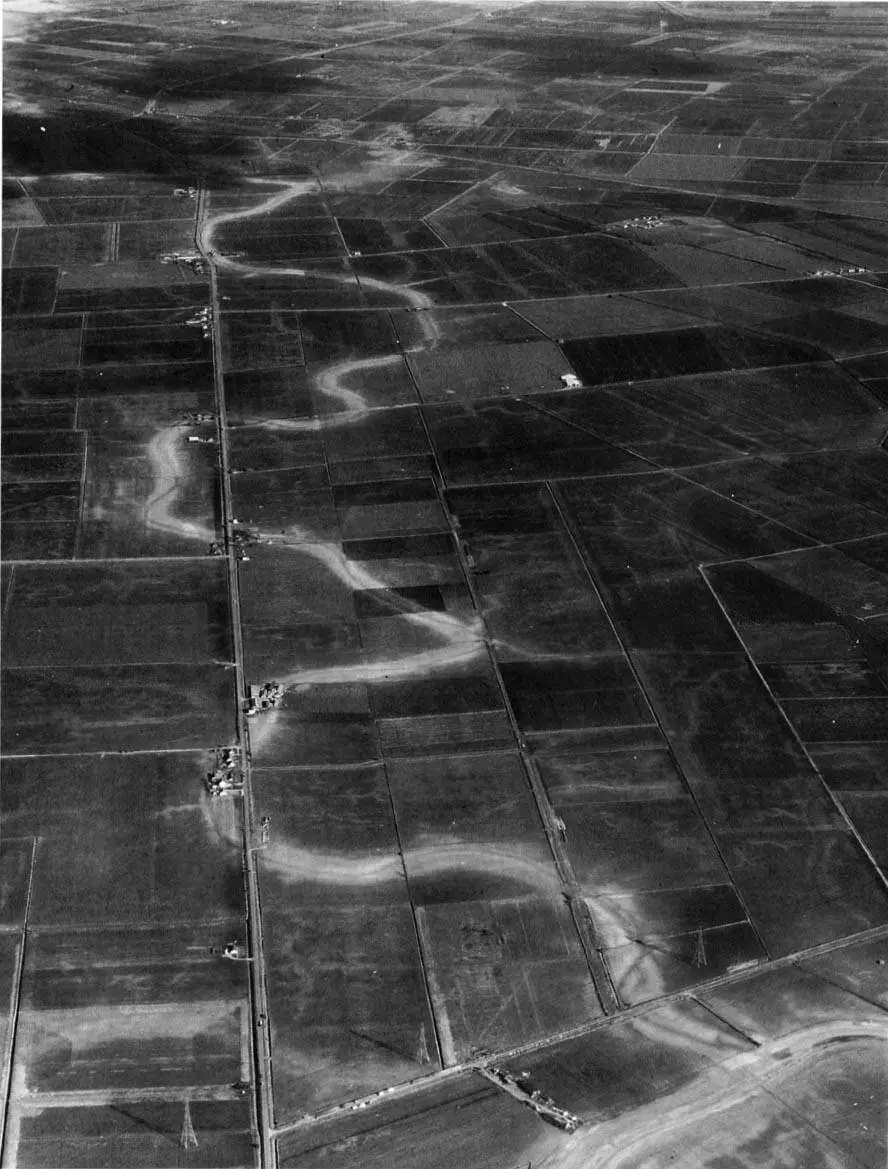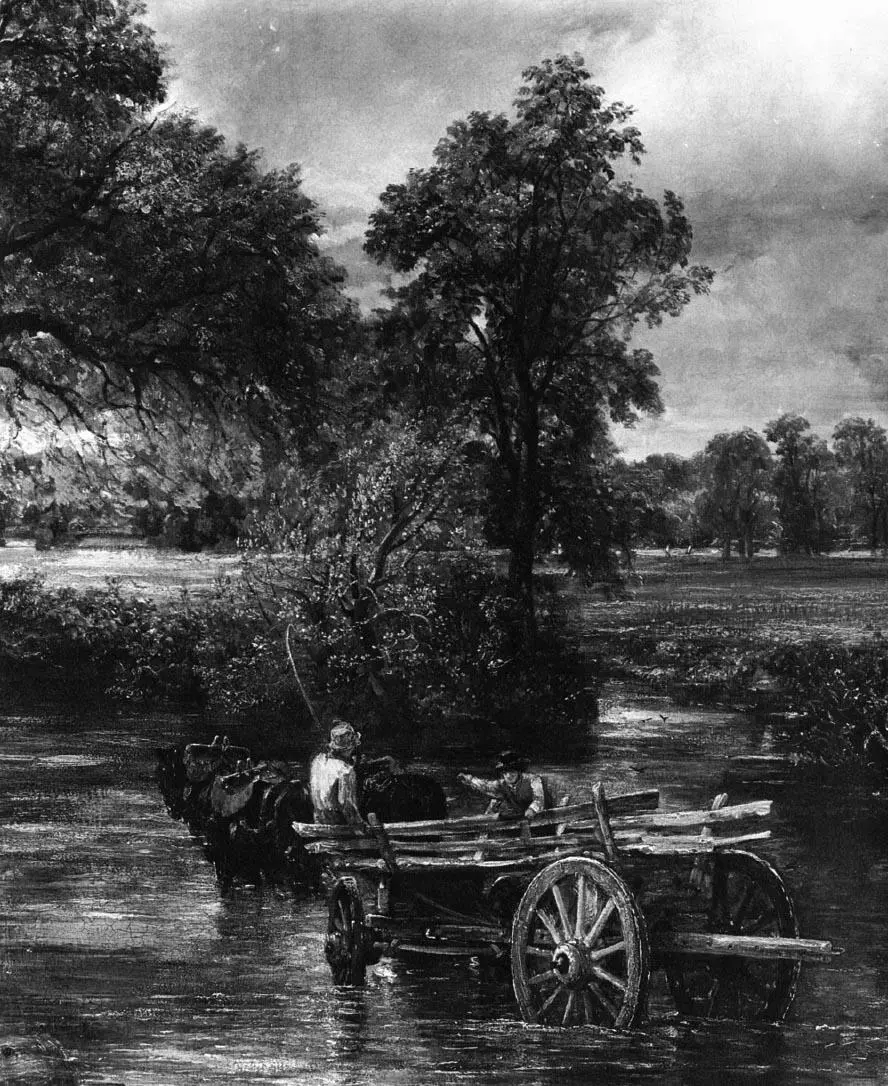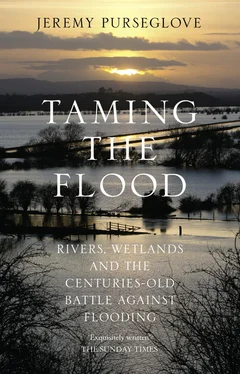Take another look at The Hay Wain . Constable was a miller’s son, and probably knew all there was to know about mills such as Flatford. He was concerned here above all to paint a working landscape, not just a decorative one; and the empty wain is fording the stream to collect more hay from the labourers in the distant field. It was probably there for another reason too. George Sturt, who wrote about his practical experience of running a wheelwright’s shop at the end of the nineteenth century, describes the constant problem of shrinkage of timber wheelstocks in high summer:
Men who used carts knew something about the advantage of a little moisture for tightening wheels. Not for the horse’s sake alone was it that carters would drive through a roadside pond, or choose to ford a stream rather than go over a bridge beside the ford. The wheels were better for the wetting. 11

The ghost of a long-vanished river winds across the level geometry of the Fens. The silt bed of the old river now stands out against the adjacent black peat. © Cambridge University Collection of Air Photographs.

Cartwheels soaking in the river in order to tighten them. Constable’s famous hay wain was part of a working landscape, not simply a picturesque one. © National Gallery.
Sturt and others record how wagons for the Sussex clay country were designed with broad wheels, while those for downland chalk had narrow ones. Taking individual orders from customers, the wheelwright built each cart for the particular conditions of a particular farm. This is taking a sense of the particular about as far as you can go: humanity evolving as harmoniously with the landscape as the mayfly nymph evolved in harmony with its stream. No wonder farmers tell us that they are the creators and guardians of the English countryside.
Now, for the first time in the long history of settling our islands, the guardians have become the destroyers. The landscape that generation after generation created is like a classroom blackboard at the end of a day, on which each lesson has been written without entirely erasing the previous one. Medieval ridge and furrow are overlain by a grid of more recent hedgerows. The winding Wellestream can be glimpsed through the level geometry of the Fens. In the space of a generation, we have set about wiping the blackboard clean.
THE IMPACT OF RIVER MANAGEMENT
Rivers and streams have been straightened and evened out as never before. This work has been carried out by water authorities, internal drainage boards, and many councils, in part to reduce flooding of roads and houses, but largely to increase farm yields. In the years between 1971 and 1980, an annual average of 207,217 acres was estimated to have been drained, of which ‘new’ drainage of wetlands comprised around 20,000 acres per year. 12One straightened stream begins to resemble another. River organisms’ ability to survive the disruption of floods was never evolved to withstand this kind of onslaught. Repeated dredging has removed the weedy margins upon which dragonflies depend. In the last twenty-five years, four dragonfly species have become extinct in England, while many others have shown a marked decline. Reduction of such insect populations will in turn reduce the fish population, which depends on a diversified, rather than a straightened and uniform, channel. With the loss of the fish, we can expect to lose the electric-blue flash of the kingfisher. The dredgings are put in the bottoms of furrows or are used to fill in ponds. With the virtual disappearance of the farm pond, frog populations in some parts of England declined drastically between the 1950s and the 1970s. fn7
Many streams have been stripped of their ancient boundary trees, and the knock-on effect of the drainage schemes has been to encourage farmers to turn their farms into prairies. Between 1946 and 1963, around 85,000 miles of hedges were grubbed out. 13The lowering of water levels to allow ploughing of damp pasture has removed the nesting habitat of many birds that we used to take for granted, such as snipe, lapwing, and redshank. A survey of Oxfordshire in 1982 14found only 15 breeding pairs of redshank, compared to 112 pairs in a similar survey in 1939. fn8
Studies have shown that the water vole, ‘Ratty’ of The Wind in the Willows , has become scarce in many areas, due to intensive management of river banks. 15Indeed, Ratty’s emotional, if not his ecological, headquarters, the river Pang between Reading and Newbury, where Kenneth Grahame wrote his classic, has been subjected to a notoriously insensitive drainage scheme. fn9
In some counties, such as Staffordshire, a previously common wetland plant such as reed has become a rare sight. The remains of water mills have been consistently removed; the weirs that hold up river levels have been dismantled; and millponds and millraces have been filled with the dredgings. On the Worcestershire Stour, ten mill sites have been removed in as many years. The ancient fords which hold up the water are dredged out, along with their water crowfoot. In the late 1970s, the Anglo-Saxon ‘stretford’ of Stratford-upon-Avon was taken out.
The inexorable desiccation of the Fens, the Somerset Levels, and the Lancashire mosses is exposing remarkable artefacts of early civilization, long preserved in the wet peat. But in the absence of an effective liaison between drainage engineers and archaeologists, there is a danger that such remarkable finds as the Bronze Age settlement built on a timber ‘island’ recently rescued at Flag Fen near Peterborough could be broken up by diggers or left to crumble on exposure to the atmosphere. 16 fn10
Major wetlands are obvious victims of drainage. Casualties since the Second World War have included the river Idle washlands in Nottinghamshire and large parts of Romney Marsh, Otmoor, and the Lancashire mosses. Major debates have been held since the late 1970s over the future of wetlands in Sussex, Somerset, Yorkshire, and East Anglia. Wetlands under threat have included a variety of landscapes: swamps of tall reed or reed sweet-grass; marshes of rush and sedge, which sometimes develop into scrub of willow and bog myrtle; fens, whose lush vegetation is nourished by alkaline groundwater, and which range from open pools, often the remains of peat cutting, to grazed beds of meadowsweet and iris, grading in turn to the wet woodlands known as alder ‘carr’. Additionally threatened are mires such as the mosses of the north-west, whose deep peatlands support sphagnum moss and heather, scattered with glades of birch, the favourite haunt of nightjars. Finally, there are flowery hay meadows and damp pastures, intersected by dykes patrolled by dragonflies in summer and all submerged in winter by the silver flood, which draws in dark clouds of wildfowl and companies of wild white swans. The destruction of such places in our time has been startling.
In 1983 the chief scientist of the Nature Conservancy Council, the Government’s watchdog on conservation, produced a definitive report on the destruction of habitat in Great Britain since 1949. 17Among the casualties wholly or partly attributable to drainage were 97 per cent of herb-rich hay meadows, 50 per cent of lowland fens, and 60 per cent of lowland raised mires, all lost in the space of a generation. In the mid-1980s the Norfolk Broads were losing an average of 1,500 acres per year. fn11
Читать дальше














